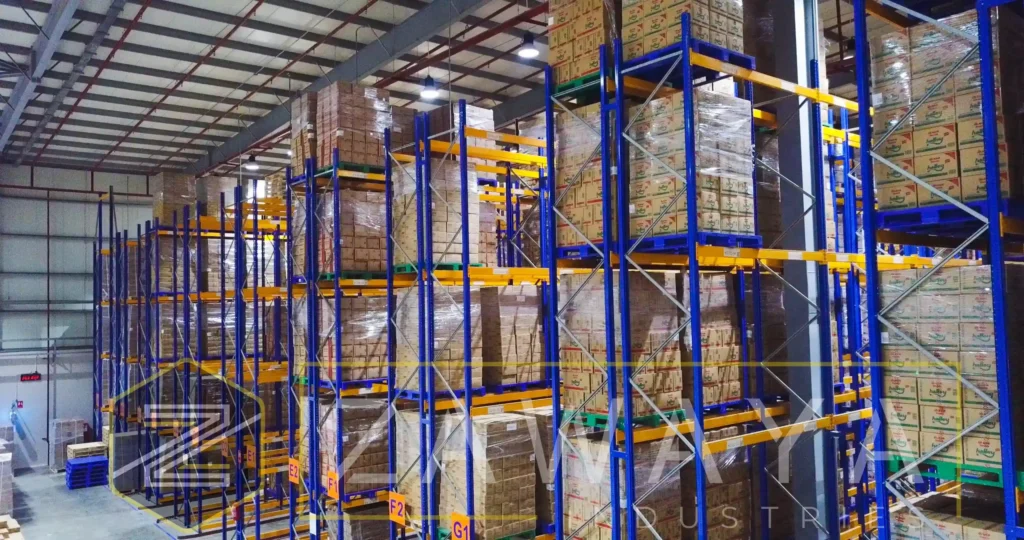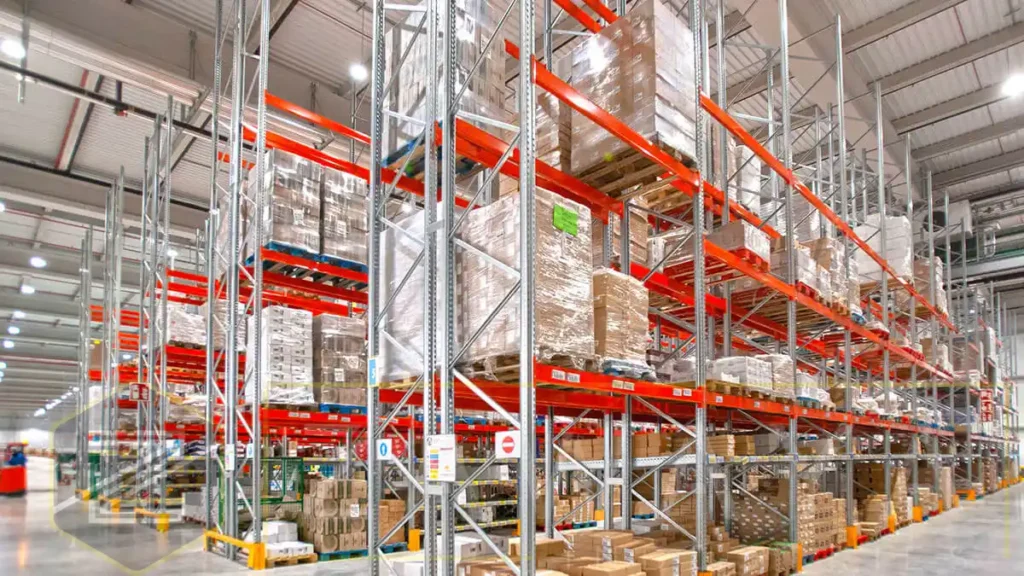

What is Pallet Racking System?
Pallet racking is a system used to organize goods on pallets or similar supports, making them easier to store and transport throughout the supply chain. Initially developed during the Second World War to improve transport efficiency, it was originally constructed mainly from wood.
Today, pallet racking primarily involves grouping frequently used items in warehouses and logistics operations, with the racking designed to accommodate heavy loads specifically intended for pallet storage. Pallet loads are essential across various logistical stages, from internal handling within warehouses to transportation.
Various types of pallets exist, differing in dimensions and materials used for manufacturing. However, most adhere to standard measurements, ensuring compatibility with industrial racking, forklifts, and other machinery involved in their handling.
[caption id="attachment_732" align="aligncenter" width="1024"] pallet racking system[/caption]
pallet racking system[/caption]
Key benefits of pallet racking
Palletising goods for storage on industrial racks offers several advantages, including:
- Streamlining loading and unloading times
- Efficient use of space through compacting goods
- Enhanced safety during product transport
- Increased flexibility for handling and transportation
- Simplified stock and inventory management
- Decreased costs associated with handling, transportation, and storage
Choosing between selective and compact pallet storage systems
Within the array of pallet storage systems outlined below, two primary types of racking stand out: selective storage systems (or those offering direct access) and compact storage systems, designed to maximise rack density for increased warehouse capacity.
Before determining the most suitable pallet racking option, the company needs to assess its storage requirements and current circumstances. During this phase, consideration should be given to whether prioritising a system that fully utilises available space is necessary, particularly if the warehouse has limited surface area or a high per square metre floor cost. Alternatively, if space availability isn't a concern and the priority lies in ensuring easy and swift access to unit loads.
Factors such as the type of products to be stored, inventory management needs, and stock rotation frequency should also be taken into account.
The most compact storage systems include automated or semi-automated solutions, which won't be discussed in this list, as the focus is on non-automated pallet racking options.
[caption id="attachment_733" align="aligncenter" width="1024"] pallet racking system2[/caption]
pallet racking system2[/caption]
Types of Pallet Racking
Various systems of pallet racking are available, including:
Adjustable Pallet Racking
This system, the most prevalent and straightforward, is engineered to store pallets using forklifts that operate alongside the rows of racking. It isn't a compact system, thus necessitating a relatively broad surface for installation. Its primary benefits include direct and swift access to all stored unit loads, alongside its versatility and flexibility.
Very Narrow Aisle (VNA) racking
VNA pallet racking is a modification of the adjustable pallet racking system, designed to maximise warehouse space utilisation. By reducing the width of the work aisles, less floor space is required for installation while retaining direct access to all stored pallets.
Special narrow aisle forklifts are required to navigate and operate within the warehouse.
Double Deep Pallet Racking
Double deep pallet racking is a further development of the adjustable pallet racking system, designed to enhance storage capacity.
In this setup, efficiency is improved by incorporating an additional pallet position at the rear of the racking, allowing for unit loads to be stored at two depths. While the benefit lies in increased storage capacity, the drawback is a reduction in selectivity or direct access to each individual unit load.
Drive In and Drive Through Compact Systems
Both Drive In and Drive Through Compact Racking represent a form of high-density pallet racking system designed to maximise warehouse space utilisation.
In these systems, work aisles are eliminated, and forklifts enter the racking structure for loading and unloading operations.
Drive In racking operates on the Last-In-First-Out (LIFO) principle, featuring a single entry and exit aisle for the forklift. Conversely, the Drive Through system follows the First-In-First-Out (FIFO) method, with an access aisle for loading and an opposite aisle for pallet unloading.
[caption id="attachment_734" align="aligncenter" width="1024"] pallet racking system3[/caption]
pallet racking system3[/caption]
Live Storage for Pallets (FIFO)
FIFO Live Storage Pallet Racking is a storage solution characterised by its compact design and rows of rollers set at a downward angle, facilitating the movement of pallets from one end of the racking to the other.
Operating on a FIFO basis, whereby the first pallet to be loaded is the first to be removed, this system ensures optimal stock rotation within the warehouse.
Push-Back Pallet Racking
Push-Back Pallet Racking shares a similar design to FIFO live storage systems, but it operates on the LIFO (Last in, First out) principle.
In this system, when a forklift loads a new pallet, it pushes the preceding pallet further back. Utilising beds of rollers or trolleys, the Push-Back system enables pallet displacement through pushing.
Mobile Pallet Racking
In Mobile Pallet Racking systems, the structure is positioned alongside chassis guided by rails on the floor, facilitating lateral movement of the racking modules.
This compact arrangement allows forklift operation by creating open work aisles through the displacement of the racking blocks.
pallet racking system cost
A frequent question from customers revolves around how to determine the cost of pallet racking.
Regrettably, there's no straightforward way to estimate the overall cost without discussing your specific racking requirements with a supplier. Numerous variables influence the cost of pallet racking, making it challenging to provide an accurate and fixed estimate.
At zawaya we prioritize transparency and honesty with our clients. While it might be tempting to provide rough numbers, we believe in offering realistic and truthful information.
If you're considering any type of racking, how can you assess the total pallet racking costs? It's essential to understand the various factors that influence rack pricing.
Key Factors in Determining the Cost of Pallet Racking
Although pallet racking might appear straightforward, multiple elements influence its cost While some factors like weight capacity and height are expected, others, such as market conditions, might come as a surprise to customers.
Here are the primary factors that impact racking costs:
Weight Capacity
Pallet racking systems are engineered to store heavy items and materials. Exceeding the recommended weight capacity is not only inadvisable but also dangerous.
Where can you find the recommended weight capacity?
Each racking system includes a rack system information plaque. Additionally, Load Application and Rack Configuration (LARC) drawings, which may be mandated by the Rack Manufacturers Institute (RMI) and certain building codes, indicate the maximum loads and allowable beam elevations for the system.
Consequently, racking systems constructed with more expensive materials and designed to support higher weight capacities, such as structural steel racking, tend to be more costly.
